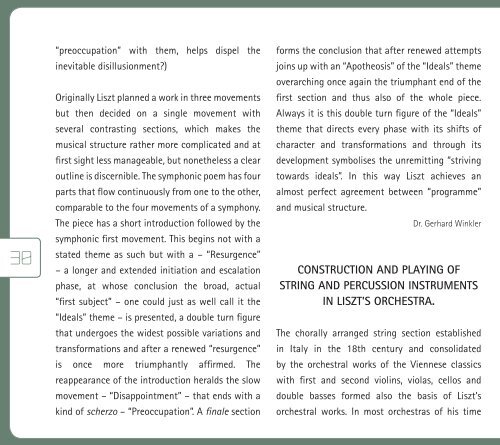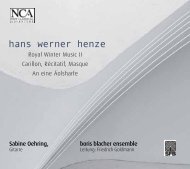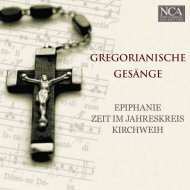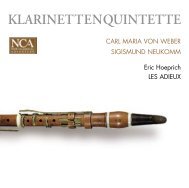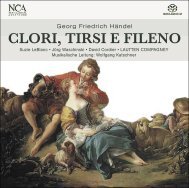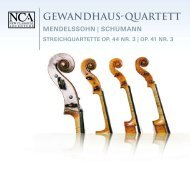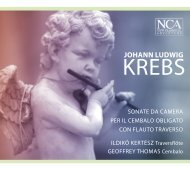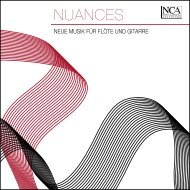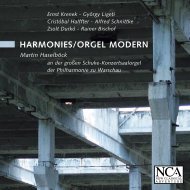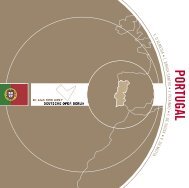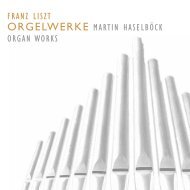FRANZ LISZT - nca - new classical adventure
FRANZ LISZT - nca - new classical adventure
FRANZ LISZT - nca - new classical adventure
- No tags were found...
You also want an ePaper? Increase the reach of your titles
YUMPU automatically turns print PDFs into web optimized ePapers that Google loves.
“preoccupation” with them, helps dispel theinevitable disillusionment?)Originally Liszt planned a work in three movementsbut then decided on a single movement withseveral contrasting sections, which makes themusical structure rather more complicated and atfirst sight less manageable, but nonetheless a clearoutline is discernible. The symphonic poem has fourparts that flow continuously from one to the other,comparable to the four movements of a symphony.The piece has a short introduction followed by thesymphonic first movement. This begins not with ainstruments of different origins and ages wereplayed (as is commonly still the case today). OldItalian string instruments (especially those ofthe Cremona violin makers Amati, Stradivari andGuarneri) were surrounded already then with anaura of the extraordinary. When Liszt was a boyalmost all these instruments had been rebuilt,a trend that began in Paris. They were given a<strong>new</strong>, angled neck with a longer fingerboard anda higher bridge, less to produce a louder tone(string instruments producing a good volume hadlong since been preferred) than to accommodatea playing technique that increasingly made use ofstated theme as such but with a – “Resurgence”upper positions. In a second wave of modifications solos were a rarity. Frequently one comes across30 31– a longer and extended initiation and escalationphase, at whose conclusion the broad, actual“first subject” – one could just as well call it the“Ideals” theme – is presented, a double turn figurethat undergoes the widest possible variations andtransformations and after a re<strong>new</strong>ed “resurgence”is once more triumphantly affirmed. Thereappearance of the introduction heralds the slowmovement – “Disappointment” – that ends with akind of scherzo – “Preoccupation”. A finale sectionforms the conclusion that after re<strong>new</strong>ed attemptsjoins up with an “Apotheosis” of the “Ideals” themeoverarching once again the triumphant end of thefirst section and thus also of the whole piece.Always it is this double turn figure of the “Ideals”theme that directs every phase with its shifts ofcharacter and transformations and through itsdevelopment symbolises the unremitting “strivingtowards ideals”. In this way Liszt achieves analmost perfect agreement between “programme”and musical structure.Dr. Gerhard WinklerCONSTRUCTION AND PLAYING OFSTRING AND PERCUSSION INSTRUMENTSIN <strong>LISZT</strong>’S ORCHESTRA.The chorally arranged string section establishedin Italy in the 18th century and consolidatedby the orchestral works of the Viennese classicswith first and second violins, violas, cellos anddouble basses formed also the basis of Liszt’sorchestral works. In most orchestras of his timecame very much stronger bass-bars, and chinrests advocated by Louis Spohr. New instrumentswere built exclusively in this manner. At about thesame time, again starting in France and spreadingthroughout Europe, <strong>new</strong> kinds of modern bowsbegan to establish themselves, particularly thosemade by members of the Tourte family and stillobligatory today. So the string section duringLiszt’s time as conductor at Weimar would nothave differed significantly from that usually foundtoday. However, the string sound that was thenproduced would certainly have been noticeablydifferent from today’s as at that time only gutstrings (and quite weighty ones) were employed,and orchestral vibrato was used, if at all, onlysparingly (in solos).The division and coupling of all the parts canbe seen as a characteristic and modern featureof Liszt’s string writing. Liszt divides groupsof instruments either in several equally strongparts or gradates them according to desks (“2single violins” or “4 first violins”). Long stringdeliberate reductions in the size of his musicalforces, determined by programmatic requirements,sometimes by omitting instrument groups as inVon der Wiege bis zum Grabe (“From the Cradle tothe Grave”) where the cellos and double basses aremissing. The rich gradations of the string sectionin Liszt’s orchestral compositions (forward-lookingtowards Richard Strauss, Gustav Mahler, andArnold Schönberg) may be seen as a link betweeninstrumental structuring and modificationsenglish


